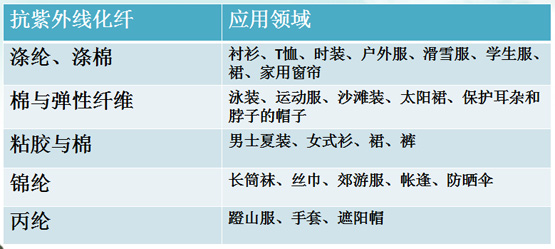UV protection fabric
UV protection fabric
In recent years, due to large amounts of halogen-containing compounds such as Freon being emitted and remaining in the sky above the earth, active chlorine formed by ultraviolet decomposition has a chain chemical reaction with ozone, causing the ozone layer in the air to be destroyed and forming holes, causing ultraviolet rays to irradiate the ground, causing ultraviolet rays to Can cause damage to human skin. Scientists predict that the amount of stratospheric ozone will decrease by about 20% by 2050, and by then ultraviolet rays will cause greater harm to human health. Therefore, fibers and textiles with UV protection functions have been developed.
1. The principle of UV resistance of textiles
There are two mechanisms of action of UV-resistant textiles: absorption and reflection. Correspondingly, there are two types of UV shielding agents: absorbers and reflectors (or scattering agents). Absorbers and reflectors can be used alone or mixed.
Ultraviolet reflectors mainly use the reflection and scattering effects of inorganic particles to prevent ultraviolet rays from penetrating. Ultraviolet absorbers mainly use organic substances to absorb ultraviolet light and convert energy, releasing or consuming the energy in the form of heat energy or harmless low radiation. Anti-UV textiles processed with appropriate methods can achieve good anti-UV effects no matter what fiber material they are, and the influence of factors such as thickness and color of the fabric on UV performance is no longer important.

2. Processing methods of UV-resistant textiles
The manufacturing methods of UV-resistant fabrics can be divided into the following two categories:
One kind of post-finishing method is to use UV screening agent to add UV protection function to textiles through dipping or coating.
The other type is to spin ultraviolet-proof fibers, which are made by mixing the ultraviolet shielding agent into the spinning solution or spinning the shielding agent and the spinning solution together to produce sheath-core structured fibers.
1Post-finishing method
The processing method of using ultraviolet screening agent through dipping or coating belongs to the processing category of textile finishing. The key to this embedding technology is to firmly combine the screening agent with the textile fiber.
The coating method generally involves adding an appropriate amount of UV shielding agent to the coating agent. Use an applicator to apply a precise fine coating on the surface of the fabric, and then dry and perform necessary heat treatment to form a thin film on the surface of the fabric. Although this type of method affects the washing fastness and hand feel, it has wide applicability to fiber types, low processing cost, and does not require high application technology and equipment. Most of the UV shielding agents suitable for the coating method are highly refractive inorganic compounds, and their UV absorption effect is related to their particle size.
The dipping method can be implemented directly on the dyeing equipment, and the dipping process has a great impact on the feel of the product.
Summer clothing fabrics are mainly light and thin, and dipping is more suitable for processing; outdoor products, including sportswear, sports and leisure wear, etc., that have requirements for hand feel can be processed by dipping, and thicker clothing materials can be processed by dipping. As well as parasols, tents, etc., the coating processing method is more suitable.
The combination of masking agent and fiber can be achieved by two methods:
One is to link the molecules of the masking agent to the macromolecules of the fiber through cross-linking agents. The fibers applicable to this method are mainly cellulose fibers, and there are already natural fibers that can participate in the reactive groups.
The second is to mechanically adhere the masking agent to the textile fibers through an adhesive. Inorganic screening agents are combined with fibers in this way, either by impregnation or coating.
2 Anti-UV fiber
Incorporate ultraviolet shielding agents (organic or inorganic substances) during spinning, and use blending spinning, core-sheath spinning and other methods to spin. Fabrics woven from this fiber are better than finishing methods in terms of style and washability. Japan’s Kuraray Company first developed “Esmo” fiber, which is made by incorporating ZnO particles into polyester chips and spinning them. Domestic Tianjin Petrochemical Research Institute used ceramic micropowder mixed with polyester polymer spinning to develop UV-resistant polyester short fibers and networked low-elastic yarns.
3 Use of UV-resistant fiber and fabric finishing
When UV absorbers and UV reflectors are applied at the same time on fibers or fabrics, they can synergize and provide even better protection. For example, Unica’s Tornado UV first uses polyester filaments containing special ceramic powder to make fabrics, and then processes them with organic ultraviolet shielding agents. The resulting fabric has an ultraviolet shielding rate of more than 90%.
Applications of UV-resistant fabrics
UV-resistant textiles made by adding UV-shielding agents to fibers, yarns and fabrics have significantly improved UV protection capabilities. Their UV-shielding rates can generally reach more than 90%, and some are even above 99%. At present, polyester, wool, hemp, silkworms, etc. with anti-ultraviolet function have become the raw materials of choice in the downstream textile industry.
In recent years, foreign companies such as Japan have made remarkable achievements in developing anti-UV fibers. The processing method used by Japanese companies to manufacture anti-UV fibers is generally to impregnate organic ultraviolet absorbers or mix ceramics that can scatter and absorb ultraviolet rays into the fibers. particulate method. The former method is mainly used for cotton fibers, and the latter method is mainly used for polyester fibers. Generally, ceramic particles are mixed in before polymerization, and then polymerized to make the ceramics uniformly dispersed.�The raw solution is spun to obtain UV-resistant fiber. TiO2 series ceramics are mostly used.
In recent years, the development of UV-resistant fibers in our country has also been rapid, especially in the development of polyester UV-resistant fibers.
Currently, most UV-resistant clothing on the market is chemical fiber and chemical fiber blended fabrics, but the focus of each chemical fiber application field is different.
Application fields of various UV-resistant chemical fibers

Among them, UV-resistant polyester fiber is very suitable for the production of various types of woven and knitted clothing fabrics. It can be purely spun or interwoven. It is mainly used for processing summer clothing fabrics, sun hats, parasols, summer women’s stockings, etc., and its weaving performance Good, the fabric style is unique and feels comfortable. Anti-UV polyester fabric has a strong UV shielding rate (up to 98%), and the product is non-toxic, odorless, long-lasting in functionality, and non-irritating to the skin. It is expected that this product is a textile raw material with great market development potential that integrates functionality, health care and comfort.
Disclaimer:
Disclaimer: Some of the texts, pictures, audios, and videos of some articles published on this site are from the Internet and do not represent the views of this site. The copyrights belong to the original authors. If you find that the information reproduced on this website infringes upon your rights, please contact us and we will change or delete it as soon as possible.
AA








